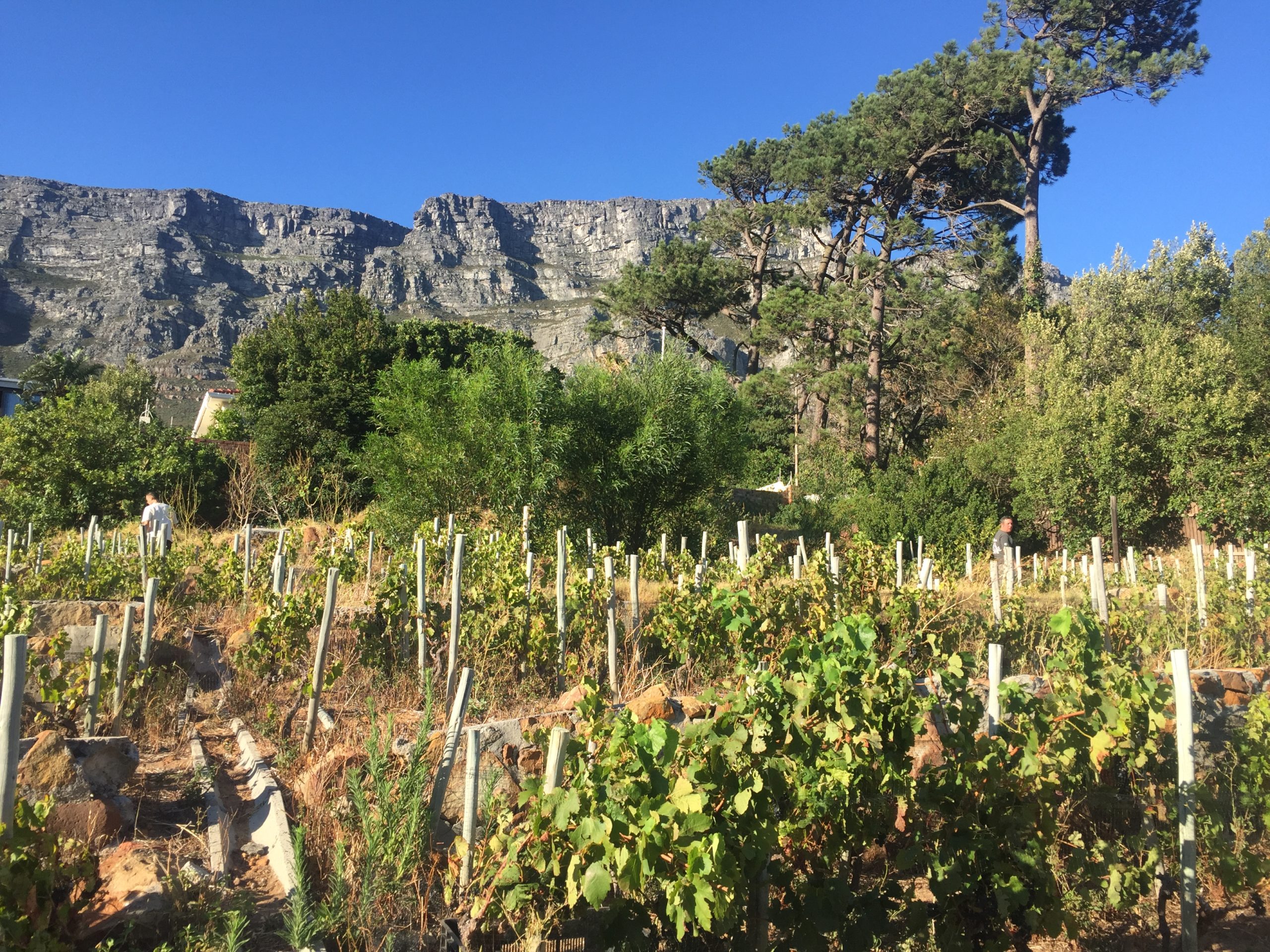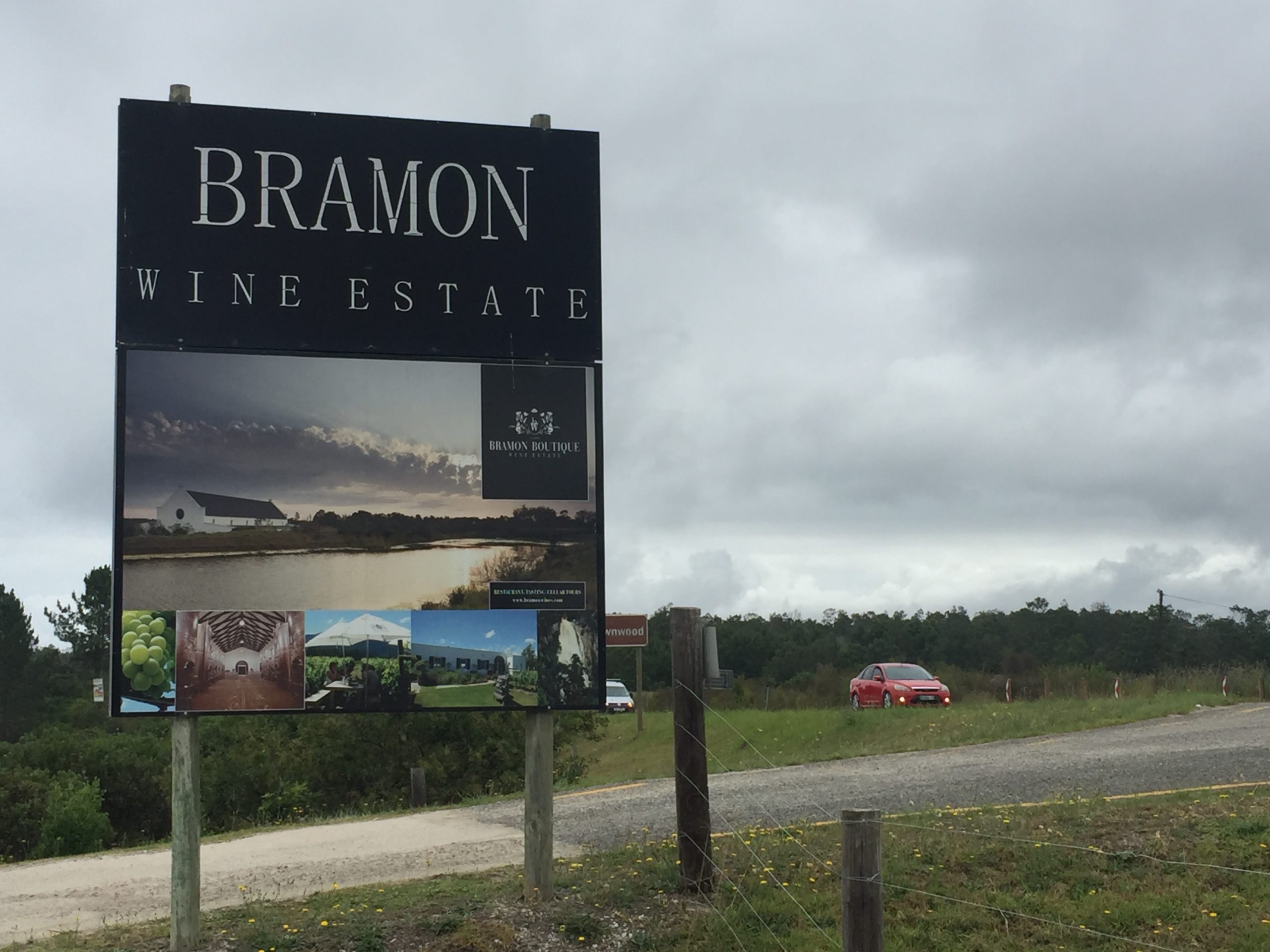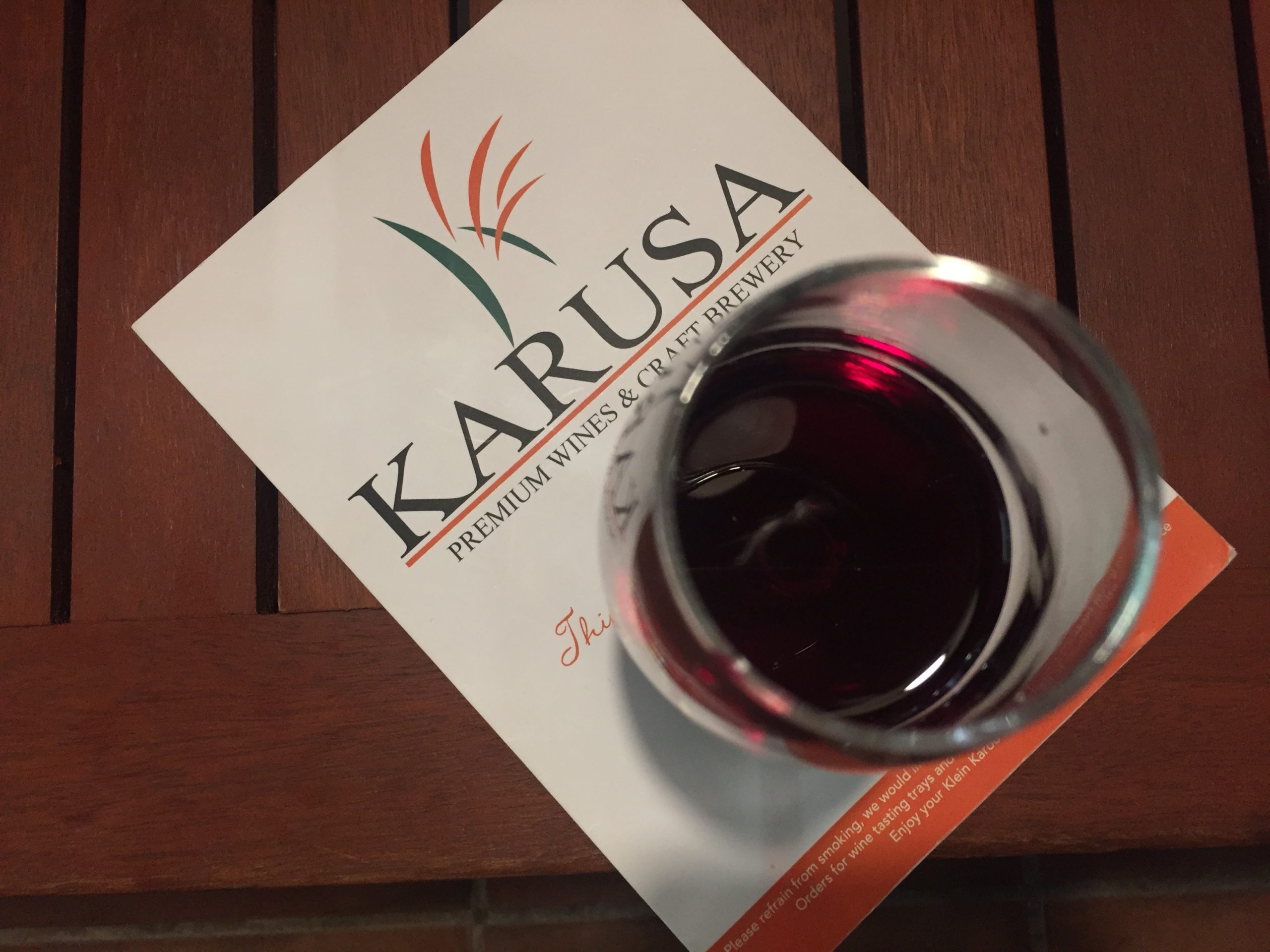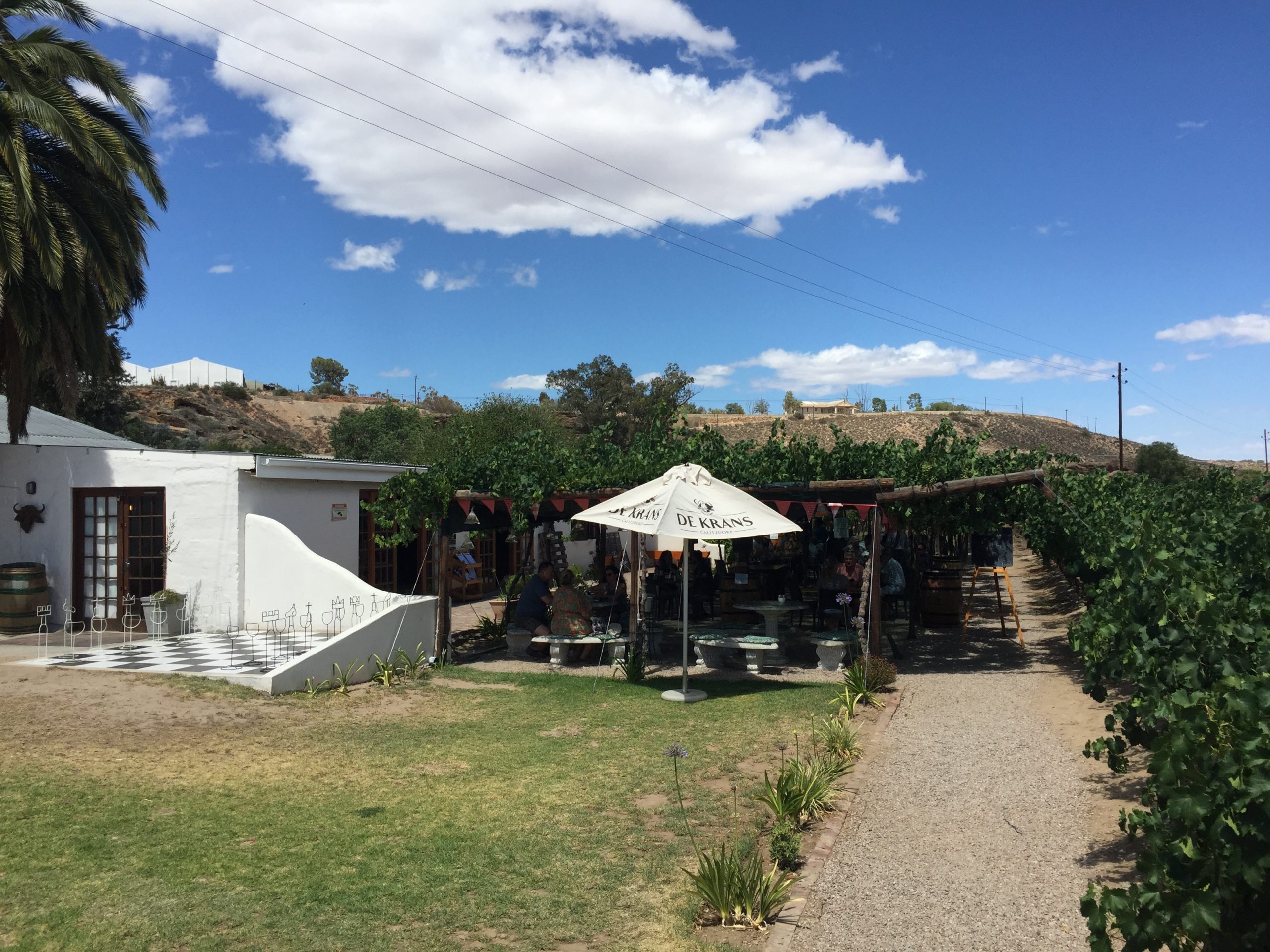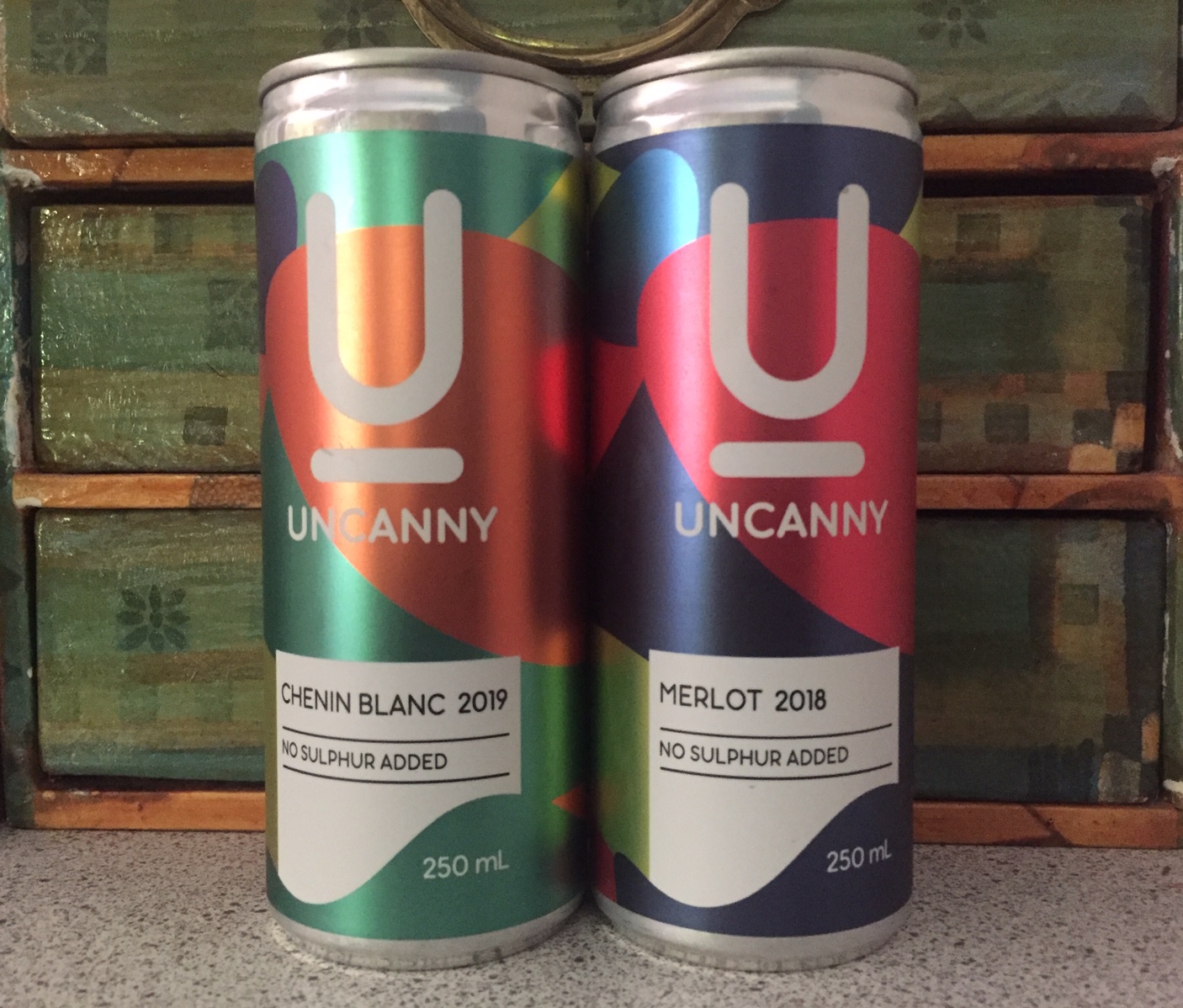Wine Cellar the Top Fine Wine Seller
WINE CELLAR
Monday 16 March 2020
https://www.winecellar.co.za/
Dr Peter Rating – Website: 5/5
Dr Peter Rating – Experience: 5/5
Ask yourself what makes a great online wine merchant? What criteria do you go by? Remember too that, like a supermarket or most specialist retail stores, you cannot taste the wines in advance. You have the convenience of being able to order from your home computer or even mobile phone, without the need to travel to your favourite wine estate for prior tasting. This is an extra benefit in these uncharted coronavirus days when many wineries regrettably, but understandably, are closing their doors to visiting tasters. I came up with these Top 6 criteria:
- Wide range of national and international wines
- Comprehensive, informative, easy-to-use and up-to-date website
- Competitive pricing
- Excellent customer care, service and advice
- Rapid cost-effective, secure delivery
- Additional services and offerings
Wine Cellar specialises in fine local and international wines and is based in Observatory, Cape Town. Business partners David Bryce and Richard Burnett established the company in 2000, although their common wine interest harks back to UCT and UK student days in the 1960s. The day-to-day business has been run by Managing Director, Roland Peens since 2005 who oversees a team of 15 persons who cover the essential functions of Sales, Fine Wine Sales, Brokerage & Investments, Office Management, Logistics, Finance, Marketing, Web Design, IT, Cellar and Stock Management.
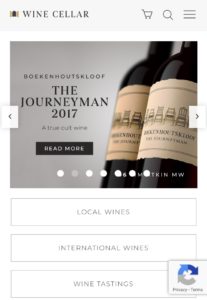
I confess I buy the bulk of my South African wines from estates that I visit for tasting. It not only means I can review their wines and the tasting experience but that I can sample the wines before buying. Not everybody has that luxury and so online buying offers a valuable alternative. Wine Cellar lists close to 1,000 wines of which 550 or thereabouts are South African with circa 440 from around the world. They include all the main wine styles: red, white, rosé, sparkling, sweet and fortified. The South African collection ranges from AA Badenhorst (clever marketing there, akin to 1-2-1 Taxis and AA Taxis in the Yellow Pages era) to Yardstick which as close to an A-Z of national wine as one can get. The wines come from over 30 regions. These are dominated by Stellenbosch (188 wines) and the Swartland (88 wines). Franschhoek surprisingly is under-represented with just 10 wines whilst at the other end of the spectrum there are wines from regions few might have heard of, for example, Philadelphia that lies between Durbanville and Malmesbury, and Prieska on the banks of the Orange River in the Northern Cape.
As for the international wines, I largely buy in support of my academic wine studies (WSET Level 4 Diploma) as well as for personal enjoyment. Wine Cellar offers wines from all the major producer countries: Australia, Austria, Chile, France, Germany, Italy, New Zealand, Portugal, Spain and the United States. There is even 1 bottle sold from China. Oddly, given the wide range of countries listed, there are no wines from Argentina which is the world’s 5th largest producer. I would have expected to buy Malbec and Mendoza wines and perhaps from Hungary (Tokaji and Egri Bikavér) or even Greece. The latter country because of the popular attention to climate change and the vogue for drought-resistant and indigenous grape varieties. Jordan, incidentally, has recently planted white Assyrtiko.
Nonetheless, this is an impressive and comprehensive selection of wines from South Africa and the rest of the world that well passes my first criterion. This is only bettered, from my estimation using current online listings, by Port2Port (1,573 wines: 866 from South Africa, 707 world wines). Wine Cellar is thus on a par with Caroline’s Fine Wine Cellar (1,257 wines; 697/492 South Africa/International wines) and far ahead of importer Great Domaines (510 wines; 84/426 South Africa/International wines) and wine.co.za (South Africa wines only) when it comes to the range of wine offered.
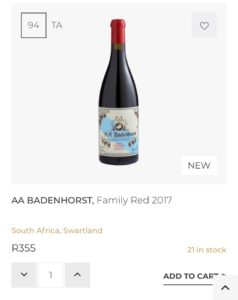
There is little point in offering such a comprehensive listing if one is unable to find the wines that one wants to buy. This is where Wine Cellar excels. The website is one of the easiest to use – and I am not limiting this comment to online wine companies alone. Click on the ‘SHOP’ button and one is led to a choice of ‘STYLE’, ‘REGION’ and selected other choices, including Wine Cellar and Customer favourites (70 and 44 wines, respectively), mixed cases, vintage wines, highly rated wines, and even en primeur/futures. The Shopping Options are conveniently grouped according to Producer, Country, Region, Style, Variety, Vintage, Bottle Size and Price. Each of these sections offer simple drop-down menus to aid buying choice. There is a high-level Search function as well as the ability to order by Product Name, Price, Vintage or Producer. The online shopper can also choose whether to see 24, 48 or 96 wines on a page, mark individual wines for a personal ‘Wish List’, and decide if to view in Grid or List display. Throughout, the website is fast, responsive and error-free.
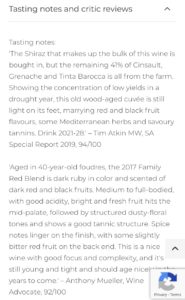
The information provided for each wine is equally comprehensive and impressive. Not only is the Score and its rating author shown at the top level (before clicking on the wine itself) but the Price, Country/Region and Number in Stock are also shown. Select any individual wine from the excellent photograph and the website leads you a mine of information. This is as detailed as any wine buyer needs except for Tasting Analysis items such as the alcohol level, which is listed for some but not all wines in the Tasting Notes section, as well as sweetness/residual sugar. Included is a brief summary inter alia about the Producer, a Tasting Note, Viticulture and Winemaking, details of bottle size, country, rating, when to drink/keep, price, producer, region and variety. Below, there are sections for Customer Reviews (albeit from a casual look I could not find any) and Shipping Information. A side-note covers delivery, online payment means and security, who to call for buying advice and shipping timing.

In addition, look under the ‘EXPLORE’ tab and you will find excellent information about: Wine Countries, their regions, common red and white grape varieties and wines; individual Grape Varieties; and Food & Wine Pairing.
Wine Cellar will sell you a bottle of wine for R60 or R80,000 and at any price in between. Buying online is great when one knows the product and the product is exact. To latter extent, a bottle of wine is a commodity. A 2015 Kanonkop Cabernet Sauvignon (say) is the same wine bought online or from a supermarket, other general retailer, or specialist store. A simple Google search will direct you to plenty of sellers in South Africa and worldwide. Look at the www.wine-searcher.com site and you can research prices for local and international wines. The Wine Cellar price of R410 per bottle is very competitive and the lowest on the Wine Searcher website considering whether local sales tax is included, minimum bottle order number and other hidden costs, delivery included. This price is below that offered online by Kanonkop itself (R450). Compare prices for a Hamilton Russell 2018 Chardonnay or Pinot Noir, a 2018 De Grendel Koetshuis Sauvignon Blanc, or a 2017 Glenelly Glass Collection Syrah and Wine Cellar is as competitive as any online supplier. It is more difficult to compare prices for international wines as each importer has their preferred producer. That said, and I buy much French and other international wines in support of my WSET studies, Wine Cellar prices well compare for Bordeaux, Burgundy or Loire wines as any other importer.
There is no substitute either for good customer care or advice. I have only ever found the Wine Cellar team, most commonly Aimée Beaumont, to be entirely professional and helpful. There has always been a smile and a welcome when I have collected my wines from Observatory and the wines ordered have been correctly selected, packaged and priced as well as being immediately available.
Prompt, secure and fault-free delivery is mission-critical for any online company and no less for Wine Cellar that is selling a product that is heavy, bulky and liable to breakage or loss. I am fortunate to live locally in Cape Town so able to collect my wines from Wine Cellar in Observatory hence I am unable to comment on the delivery service. Price must always be factored into any online purchase and here I am able better to compare. Wine Cellar delivery is free to anywhere in South Africa for orders totalling over R1,500. This equates to a case of medium-priced wine, a reasonable fee given the vast size of the country. The website gives a scale of charges for up to 12 bottles for purchases below this amount, ranging from R60 in Cape Town to R130 for Joburg/Pretoria/Bloemfontein to R210 for elsewhere. International delivery is available on request. Like bottle price, these rates are competitive when compared with other online suppliers. The Port2Port portal may list more wines, for example, but it is easy to be caught out on delivery costs as they source from different suppliers, with the result that one order may be split between several suppliers. Not only does this mean, and I have been caught out on this, that the delivery fee is multiplied but also that one likely has to receive a single order on different days which is a distinct disadvantage if having to be home to receive.
Wine Cellar does not only sell wine online. It offers a wide array of other services. This ranges from gift-wrapping and selected monthly or mixed case offerings, to gift vouchers to Gabriel glassware. The company also offers a comprehensive investment and advice service to enable wine enthusiasts to build up a portfolio of local and international wines. There is a cellaring service which I have not used (yet!) but which I have heard only good reports of. Stable and correct heat, light and humidity are essential for long-term wine storage, as is the security of any investment wine. The minimum storage time is 6 months. Mixed cases can be stored but they attract a higher fee than un-mixed cases due to the obvious extra cataloguing and administration. Additionally, Wine Cellar is pioneering the fine wine auction sector, pairing up with Strauss & Co who are one of South Africa’s leading auction houses. The market is developing, and it is early days as consumers are not yet in the habit either of laying down wine, buying wine as an investment, or even generally knowledgeable about the emerging fine wine sector and its wine. I have been to one pre-auction Fine Wine tasting and was impressed by both the quality, age and range of local and international wines on offer.
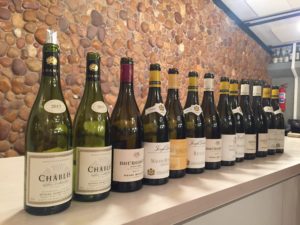

Whilst I have little used the above extra services, I am a frequent attender at the Wine Cellar tastings (regrettably but understandably suspended temporarily due to the coronavirus). These are held every 1-2 months in Observatory (Johannesburg also) in a neat upstairs Tasting Room. I have been to evenings that have offered a tasting of AA Badenhorst, 2016 Bordeaux, 2017 Burgundy Whites, 2017 Burgundy Reds, South Africa MCC v Champagne, and Piedmont wines. The fee varies but is usually between R450 and R750 for 12 wines with the offer to buy at the end of the tasting. The evenings are hosted by Roland Peens who has a natural and enthusiast but geeky flair that easily rubs off, together with an exceptional knowledge of the wines offered, their producers, the viticulture and viniculture and the respective wine regions. I highly recommend attending if you are able, whether novice, student, enthusiast, wine collector or professional.
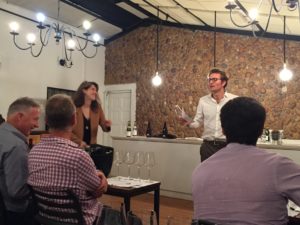
I return to my 6 selected essential criteria for an excellent online wine supplier: range of wines on offer; user-friendly website; competitive prices; customer care; effective delivery; and additional services. Wine Cellar passes all with aplomb. I have little to suggest by means of improvement other than some minor ideas I have hinted at that would put the wax on top of the wine cork. Included in these are to sell selected wines from Argentina, particularly Malbec and from the Mendoza region that not only are increasing in quality, but which also offer great value for money. The Franschhoek region is similarly under-represented, particularly for sparkling wines and top Sémillon. A modest improvement to the already excellent Wine Cellar website would be the inclusion of a Help/Web Chat facility. Many online companies are offering this and not only in the wine sector (Cotton On, for example, as well as Port2Port). This offers the customer a cheap, quick and easy means to ask order questions without having to make a phone call. It would be useful too if the ‘More Information’ section for all the wines listed Alcohol level (%) and Sweetness/Residual Sugar. The option too to search white wines for Wooded/Unwooded would also be useful. This would take some once-off effort to amend up to 1,000 wine entries but better inform the buyer.
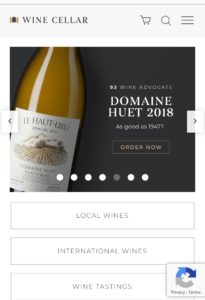
![]()

To conclude, Wine Cellar well meets and passes what is required for an online wine supplier. It is an established company with a proven record, product range and expertise. The website, its layout, information and ease of use is one of the best. The business operates at the fine wine end of the market which, whilst not as price sensitive as some, nonetheless offers an excellent range of South African and international wines at highly competitive prices (delivery included). I have had only good experiences in all my dealings with the company and I thoroughly recommend Wine Cellar for any online wine purchaser.
Perdeberg Earns Its Stripes
PERDEBERG WINES
Friday 28 February 2020
http://perdeberg.co.za/
Dr Peter Rating – Experience: 4/5
Dr Peter Rating – Wines: 4.5/5
My (new) wife told me after breakfast that she had a lunchtime business networking meeting at Perdeberg Winery. “Do I want to come with? You could do some wine-tasting”, she said. I did not need a lot of persuasion. I had been to Perdeberg before, nearly 2 years ago, for the annual Pinotage and Biltong Festival which returns for its 6th edition on 18-19 April. I had not tasted the Perdeberg wines, so this was too good an opportunity to miss.

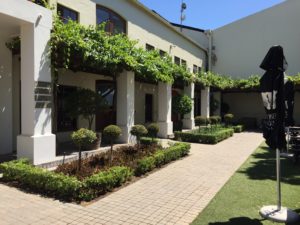
Perdeberg lies some 10 kilometres to the North West of Paarl amid dry rolling wheat land. I well remember the large cellar building that is a legacy of the former co-operative winery. It was built in 1942 by Jan Roussow so that the local wine growers could gain best prices for their high-quality grapes. It is this kind of innovation that has become a tradition at Perdeberg. It was the second cellar in South Africa to introduce cold fermentation in 1956, the first winery in the region to employ from 2010 a full-time viticulturalist and, recently, to use aerial infra-red photography for the extensive vineyards.
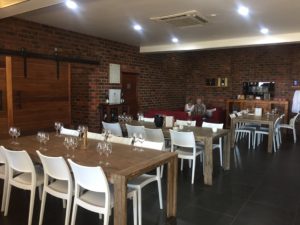
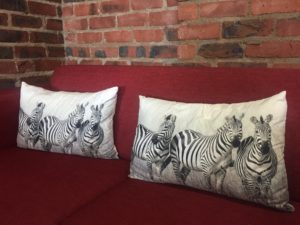
The sun shone brightly as I sought a shady space to park. Inside, the Tasting Room offered a relaxed environment. There were relatively few guests for a Friday lunchtime but, I suspect, most were enjoying the new East@Perdeberg Restaurant upstairs. Des was my attentive and efficient host. The room was simple rather than opulent, functional rather than expansive and with wine and associated product displays on surrounding shelving against bare brick walls. The tasteful decoration in black, white and red perfectly matched the Perdeberg ethos of doing simple things well. The tasting offer was 5 wines for R50 from a selection of almost 30 wines. These were divided into 3 main collections (the iconic Speciality Range (2 wines) and the easy-drinking fruit-driven Soft Smooth Range (3 wines) were not available for tasting): the Dryland Collection, from selected grapes of dryland vineyards that showcase their terroir and made in the New World style; the single variety Vineyard Collection made from specific vineyards chosen for their combination of cultivar and terroir; and the Classic Collection of elegant fruity wines that can be drunk with or without food.
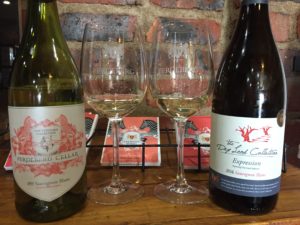
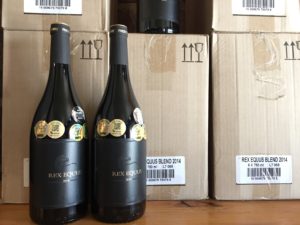
Choosing just 5 wines was a challenge and especially so when the choice included less common varieties such as Grenache Blanc, Cinsault and Malbec. Fortunately for me and knowing my interest in wine, Des was generous in allowing me to taste a wide selection. I began with a side-by-side comparison of bush vine Chenins Blanc from the Dryland Collection. Both the wines were a shiny pale lemon in colour with distinctive Chenin Blanc aromas of ripe lemon and lime citrus, tropical mango and pineapple, with an undertone of fresh herbs. The unwooded ‘Braveheart’ was crisp on the palate and fresh despite its 2015 vintage with medium+ acidity and a rounded feel at the average finish. I just preferred the 9-month French oak, barrel-fermented ‘Courageous’ that cost just R10 more. The nose was fuller and more concentrated to show a more honeyed, sweeter character together with nectarine stone fruits. The intensity of aroma followed through to the palate that was predictable more rounded, softer and with better integrated acidity. The 2 wines made an excellent start to the tasting and of excellent value for money (R100 and R110 only).
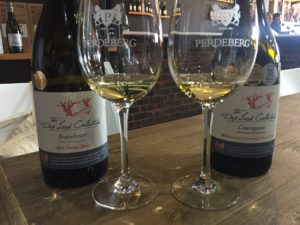
I opted for the Vineyard Collection Sauvignon Blanc next, but Des was keen for me to taste and compare with the ‘Expression’ sibling from the Dryland Collection. Their appearance was comparable, with the ‘Expression’ being a slightly deeper pale lemon in colour. The Vineyard wine was made in green style and dominated on the nose by bell pepper and grassy, herbaceous notes that developed in the glass to include lime and tropical fruits. The bright acidity on the palate led to a slight bitter finish but this was nonetheless a decent example of a warm region Sauvignon Blanc, again great value for money (R70). I much preferred the ‘Expression’ wine from the Dryland Collection. Sporting a cork rather than screwcap closure, the Sauvignon Blanc unusually was matured for 18 months in old French oak barrels with lees contact. This was very different wine albeit with the same herbaceous and green pepper aromas. These were toned down and layered with notes of sweet lemon, gooseberry, tropical fruits and vanilla. The texture was more rounded and the balance better with an integrated acidity and well worth the extra R30.
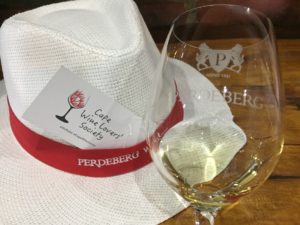

The last 2 white wines I tasted were a Grenache Blanc and a white blend called Roussow’s Heritage. Grown in just 0.14% of South Africa’s vineyards, the rare Grenache Blanc is commonly found in Rhône white blends. It is suited to dry conditions and I expect to see more wines in the future (Anysbos, for example, in Bot Rivier has recently planted). The wine, now in its second year of production, showed a medium+ fruity intensity of fresh stone fruits of peach, nectarine and lemon citrus. I detected slight notes of vanilla and white pepper to suggest a modest use of oak in maturation. Surprisingly, the intensity on the nose weakened on the palate. The acidity was firm with just the edge of sharpness rounded off (also suggesting some use of oak) to make for a clean mouthfeel. The wine makes a pleasant alternative to Sauvignon Blanc and was again excellent value at R75, when premium pricing for a rare cultivar might be expected.
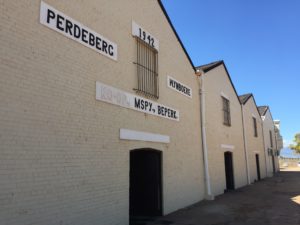
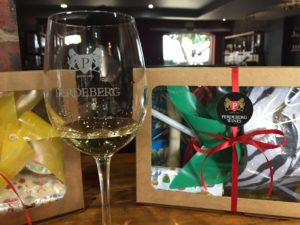
The Roussow’s Heritage of the same 2019 vintage was a Chenin Blanc-led blend (59%). Des did not know the percentages of the 5 cultivars of this Southern Rhône-style white blend, but the website does not show it either. This was my favourite wine with an inviting, medium+ intensity nose that combined the honeyed tropical fruits from the Chenin Blanc and the herbaceous grassy aromas of Sauvignon Blanc together with delicate white stone fruits and blossom. The flavour intensity held up much better on the palate than for the Grenache Blanc with an elegant, rounded texture and a decent finish.
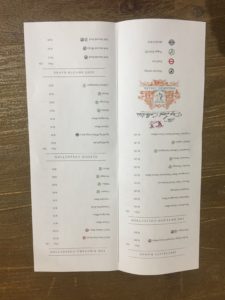

Perdeberg lies between Durbanville and Malmesbury in the Agter Paarl region. The extensive vineyards total a sizeable 2,564 hectares out of the 6,000-hectare owned property, a reflection of the former co-operative winery era. The vineyards, on varied soils, are largely un-irrigated to give concentrated fruits that benefit from cooling sea breezes during ripening. Most of the wine that is produced is red (60%) made from the Cabernet Sauvignon, Merlot, Cinsault, Pinotage and Shiraz grown in the Perdeberg vineyards. White cultivars include Chenin Blanc, Chardonnay and Chenin Blanc and hence most wines are Wine of Origin Paarl, with some Wine of Origin Coastal Region among the red wines.


Lesser known Cinsault and Malbec were the first red wines I tasted. The 2 wines were from the Vineyard Collection, of 2018 vintage. 14% alcohol and priced a very affordable R85. The pale ruby Cinsault was a more representative example of the variety than the Waverley Hills wine I recently tasted. The wine showed classic red strawberry and raspberry fruits of bold intensity in the glass with a beautiful balancing violet floral character so typical of the cultivar. The fruitiness weakened a little in the mouth but were finely balanced by a fresh acidity and light tannins to give a youthful but not overworked wine. The Malbec was also youthful but typical of the grape with a deep ruby-purple colour with delicious, luscious red and dark fruity aromas of red and dark berries, cherry and plum. Dry oaky tannins emerged on the palate to give structure to balance the ripe fruits. The Malbec is a great food wine and improve with age as the tannins soften and integrate.
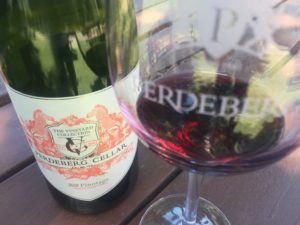

Des was not letting me taste single wines and so I sampled Pinotage and Shiraz from both the Vineyard and Dryland collections side by side. I rated the Dryland ‘Resolve’ Pinotage higher than the Vineyard wine. The 2 wines showed characteristic plush ripe, more dark than red fruits of cherry, plum, mulberry, prune and estery banana on the nose. Whilst the Vineyard Pinotage was lighter on the palate than I expected, the Dryland ‘Resolve’ showed added pepper spice for a more concentrated nose. This intensity carried through to the full-bodied palate with tight tannins that showed its youth (2017 vintage).

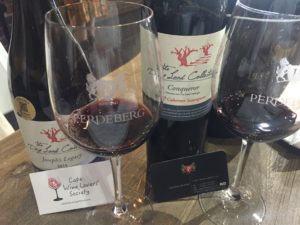
I ended the tasting – I could have sampled the Cabernets Sauvignon, Joseph’s Legacy red blend and Longevity Natural Sweet Chenin Blanc and more – with Shiraz, again from 2 collections. I scored both the same although they were different in style. Classic spicy, dark fruits of cassis, cherries, mulberry and blackberry notes hid underlying aromas of black pepper and liquorice on the nose. The Vineyard wine was fresh fruity, with a soft candy/ester Pinotage tinge, and of more delicate style hence, I imagine, the Rhône-shaped bottle. By contrast, the ‘Tenacious’ from the Dryland Collection showed greater focus and concentration of ripe fruits so typical of the outstanding 2015 vintage. The Bordeaux bottle nodded to a bigger style of wine with riper, fuller tannins that will soften with age.

Perdeberg offered an excellent range of, mostly, single variety wines and so much more than the Chenins Blanc for which the winery is known. I could have tasted or bought sparkling MCC Chenin Blanc and Rosé, Cinsault Rosé, Pinot Noir/Chardonnay blanc de noir, dessert Chenin Blanc and more. I was especially impressed by the rare cultivar wines in the collections together with the same variety made in different unwooded and wooded styles. I liked the distinctive shield-shaped label on the Vineyard Collection labels that gave a modern yet classic feel. So too did Merlot the mascot zebra, complete with own blog (!)(albeit the website link did not load), that gives a nod both to the historic wild zebra and quagga that once roamed the Paardeberg mountains and roamed the early vineyards and also to current conservation measures to preserve endangered fauna and flora. Perdeberg has clearly come a long way from its historic co-operative beginnings to produce some excellent, well-made wines. These were served at the right temperature (not always guaranteed, even at the most prestigious wine estates) and with minimum fuss. The wines offer superb value for money and I highly recommend a visit for tasting and to buy wine. Perdeberg has indeed ‘earned its stripes’!
#capewinelover #DrPeter
Wines tasted (bought *):
White:
2015 Dryland Collection ‘Braveheart’ Chenin Blanc – R100
2018 Dryland Collection ‘Courageous’ Chenin Blanc – R110
2019 Vineyard Collection Sauvignon Blanc – R70
2016 Dryland Collection ‘Expression’ Sauvignon Blanc – R100*
2019 Vineyard Collection Grenache Blanc – R75*
2019 Dryland Collection Roussow’s Heritage (Chenin Blanc, Roussanne, Viognier, Clairette, Sauvignon Blanc) – R130* FAVOURITE WINE
Red:
2018 Vineyard Collection Cinsault – R85*
2018 Vineyard Collection Malbec – R85*
2018 Vineyard Collection Pinotage – R80
2017 Dryland Collection ‘Resolve’ Pinotage R120
2018 Vineyard Collection Shiraz – R80
2015 Dryland Collection ‘Tenacious’ Shiraz – R120
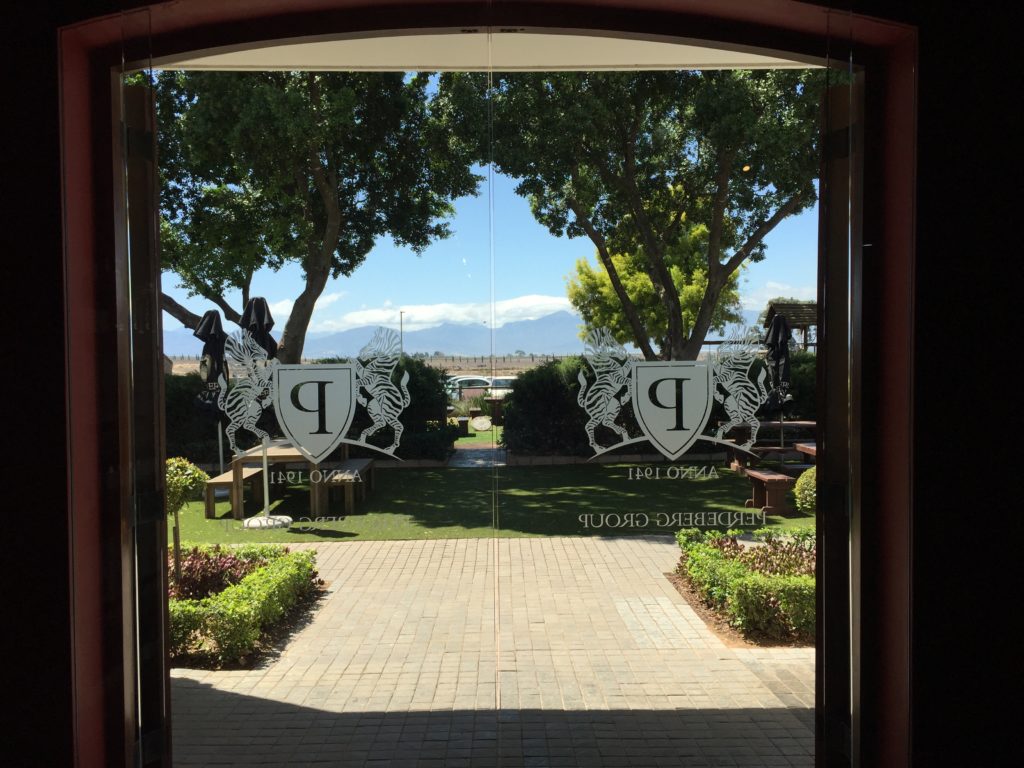
First Harvest is the Sweetest
SIGNAL HILL WINES/FIRST HARVEST
Tuesday 25 February 2020
www.winery.co.za
Dr Peter Rating – Experience: 5/5
Bramon Beside the (Plettenberg) Bay
BRAMON WINE ESTATE
Monday 30 December 2019
https://www.bramonwines.com/
Dr Peter Rating – Experience: 4/5
Dr Peter Rating – Wines: 3.5/5
KLEIN KAROO KARUSA!
KARUSA WINES
Friday 27 December 2019
https://www.karusa.co.za/wines.html
Dr Peter Rating – Experience: 3/5
Dr Peter Rating – Wines: 3/5
Putting into Port at De Krans
DE KRANS WINES
Thursday 26 December 2019
http://dekrans.co.za/
Dr Peter Rating – Experience: 4/5
Dr Peter Rating – Wines: 4/5
Visiting De Krans was a spur of the moment decision. Calitzdorp was the night stop for the second day of my trip down Route 62. I did not know where else I was going other than Route 62. The trip to Jeffrey’s Bay had been a ‘bucket list’ ambition for several years. Even better if I could sneak in some wine tastings along the way. It being the Xmas/New Year period and close to harvest this was perhaps easier said than done. Thus, late on Boxing Day afternoon, I found myself on the edge of Calitzdorp village some 400 miles from Cape Town on the Western edge of the Klein Karoo. Best known as one of the important Cape Port producers in this hot semi-arid inland region, I was looking forward also to tasting some wines. If my memory serves me right, the Tritonia red blend was a previous Best Non-Bordeaux Red Blend winner at the 2017 Old Mutual Awards.
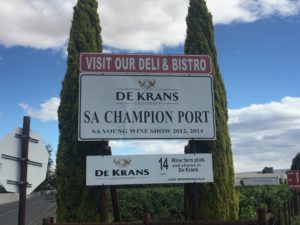
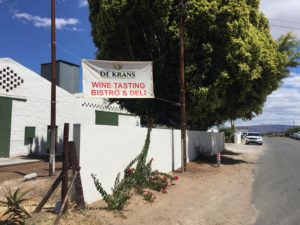
I parked in the shade beside the road a short distance away from the main entrance. The small white painted Tasting Room nestles beside the vineyards with shaded outdoor seating spilling over from the inside. The vines were heavy with grapes with long stems and V-shaped trellising to raise them above the ground. I learned after that these were Hanepoot, for public picking in February when ripe, and not for winemaking. The Tasting Room was busy – I sensed mostly with local guests – who were enjoying their wines and a light lunch from the Deli or Bistro. Xmas carols played through the Tasting Room speakers which, as a Brit used to chilly Xmases, still seems weird.
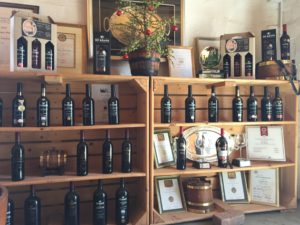

Wine tasting was a very affordable R40 for 6 wines (waived on bottle purchase). I ordered a cheese platter (R125) that was large enough to share with my fiancée. It was made up with bread and toast, 4 small cheese portions and a choice of 3 sides. Choosing 6 wines was quite a challenge given the number of and range of wines and styles available. It was good to share different tastings with my partner which made the choice a little easier. De Krans wines essentially fall into 3 groupings: Sparkling (MCC and Moscato Perlé); white, rosé and red table wines; and fortified and Port-style wines.

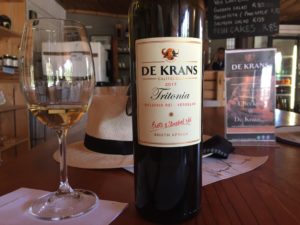
I sampled as broad a range as I could, beginning with the Tritonia White from the Flagship Terroir Range. Made from 70-year old Malvasia Rei (Palomino) and Verdelho, the two wines were blended after 4 months each on the lees with 15 months of barrel fermentation. The wine was served from a tall, heavy bottle and needed cooling to have been at its best (it was over 30ºC outdoors). Pale lemon in colour, the nose showed a mix of green and citrus notes – lemon, lime, lemongrass, green herbs and a mineral saltiness – that were simpler on the palate, showing vanilla flavours from the oak, with a medium+ acidity. This was my favourite wine.

Next was the Free Run Chenin Blanc from the entry Classic Range. The R58 price showed. Whilst it was an obvious Chenin Blanc with fresh aromas of tropical guava, ripe lemon and mango, the intensity was modest. This was matched on the palate that was dry with more citrus flavours and a short finish.
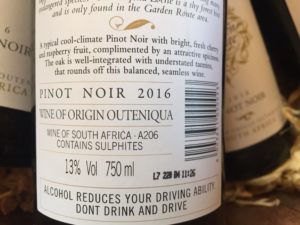
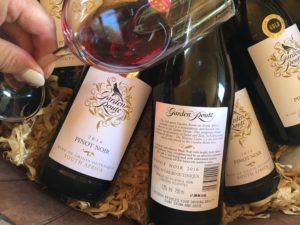
I was excited to taste a Pinot Noir that was made using grapes grown in the foothills of the Outeniqua Mountains, hence the Garden Route name and Wine of Origin Outeniqua. Pale garnet in colour and showing some signs of ageing from the 2016 vintage, the wine showed an uncharacteristic ripeness of jammy red plum, redcurrant and black cherry on the nose with slight pepper spiciness. I might have bought the wine until I tasted it. I was reminded how few Pinot Noir do well away from a cool climate. Almost certainly better had the wine been chilled, it needed more depth, layering of flavour, bite and length. I sensed the fruits had already tailed off as it had aged in the bottle.

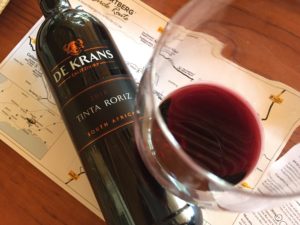
I much preferred the more robust Tinta Roriz from the Terroir Range. The first of the red Portuguese varieties I tasted, the wine was an inky deep purple in colour. There was an intensity of aroma that contrasted with the Pinot Noir – port-like and oxidised – with ripe black cherry, dark plum, cassis, ripe blueberry and herbs. These gave way to dry, earthy, dusty and chewy tannins on the palate to balance the 13.0% alcohol and medium length.
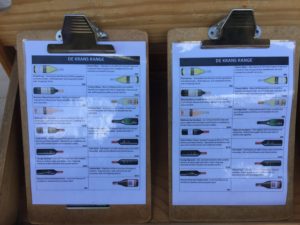

I rated the Touriga Nacional almost the same. The variety was first planted in 1994 and made into a single variety wine in 2000 aided by the continental climate and shallow clay Karoo soils that are not unlike the hot, dry Douro Valley in Portugal. The wine was similar in colour with ripe red as well as black fruits, including cassis and bramble to match an earthy spicy clove and cinnamon nose (no doubt from 12 months maturation in 3rd/4th fill French oak barrels). This was a definite food wine with firm drying, earthy tannins, though the 13.5% alcohol appeared less than expected, that filled the mouth and offered a medium+ finish.

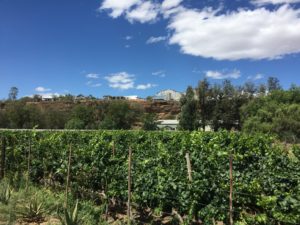
De Krans dates back to 1890 when it was bought by the Nel family. The 78-hectare estate remains family owned. Chris and brother Danie built the Cellar that is behind the Tasting Room in 1964. Chris planted the first Portuguese grapes in 1973 albeit unintentionally. There’s a parallel here to Carmenère and Merlot in Chile where supposed imported Merlot turned out to be Carmenère. The intended Shiraz that was planted in 1973 turned out in 1976 to be Tinta Barocca when the first grapes were produced. Further Portuguese varieties have been planted since 1985. Today, De Krans has 45 hectares under vine – there are peaches, apricots and the Hanepoot too – with Chardonnay, Chenin Blanc, Muscat, Cabernet Sauvignon together with the Port-producing varieties of Touriga National, Tinta Barocca, Tinta Roriz, Tinta Amarella and Souzao. Red wines amount to half of the production (50%) followed by fortified wines (37%), with 10% white wines and 3% Rosé.


The next wine I tasted was entirely different, a White Moscato made in Natural Sweet Perlé style. Perlé usually refers to a lightly carbonated wine that is often pink in colour (after the German grape of the same name). The Moscato was all that I expected: vibrant in character with floral and perfumed jasmine, Turkish delight, rose petal and grapey Muscat de Frontignan aromas and flavours; sweet on the palate with medium- acidity and low alcohol (7.5%). This was a pleasant, easy-drinking wine and perfect for a summer’s day like today. The wine was great value for money too at just R58.

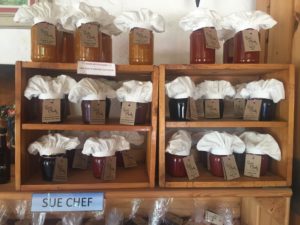
As indicated above, I had tasted the Tritonia before. De Krans call it a Calitzdorp blend (as opposed to a Cape or Bordeaux Blend) as it is made from 5 Portuguese varieties: Touriga National, Tinta Barocca, Tinta Roriz, Tinta Amarella and Souzao. These are typically used to make Port and Cape Port but these cultivars are increasing being made into table wines, even single cultivar wines. The Tritonia was deep garnet in colour with early signs of ageing at the rim (2016 vintage). Blackberry, cassis, plum, dark cherry black fruits were luscious and ripe with spices on the nose and palate. Dusty tannins – benefiting from 12 months maturation in 2nd/3rd fill French oak barrels – and high alcohol (14.0%) gave the wine a full body in the mouth with layers of flavour for an extended length at the finish.
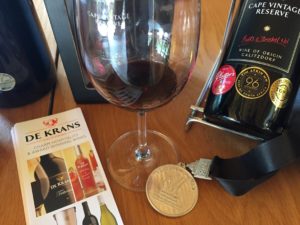

I sampled one Port in my tasting selection, the Cape Vintage Reserve. Sediment at the bottom of the glass showed this was unfiltered. The nose showed intense dried black fruits and the oxidation. This was confirmed on the palate with rich flavours of black plums, prunes, hazelnut and Dundee marmalade matured over 20 months in large vats. The Cape Port warmed by its 19.0% alcohol to give a medium sweetness of character.
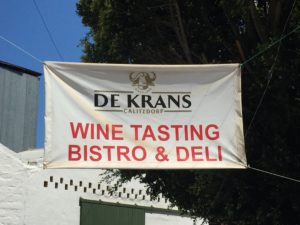

The Tasting Room Manager, Chris, asked me to taste the Pinotage Rosé that was of 2019 vintage. The wine was a very pale pink to show very little extraction with mostly strawberry and raspberry fruits on the nose. Dry acidity came to the fore on the palate to overpower the delicate fruits. The crisp mouthfeel was too sharp and biting for my preference.
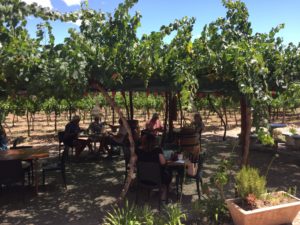
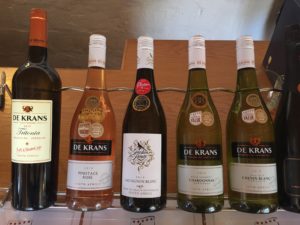
A visit to Calitzdorp and to sample the Wines of Origin from the Klein Karoo and Calitzdorp was long overdue. De Krans offered me an insight to how dry the region is and the challenge to balance vine growth and crop and the need for excellent water management. The range of De Krans wines was impressive to reflect a willingness to experiment and try new styles, notwithstanding the accidental history behind the first Portuguese grape planting. The wines were generally very good with a broad price range that reflected in their quality. I would have liked then to have been served cooler and at the right temperature. This is never easy for Tasting Rooms at intense peak visitor periods and so I am willing to set this imperfection aside and award a 4/5 experience rating. In sum, do visit De Krans if you are near Calitzdorp. Better still, venture down Route 62 and make a night stop of it.
#capewinelover #DrPeter
Wines tasted (bought *):
Sparkling:
2019 White Moscato Natural Sweet Perlé – R58*
White:
2017 Tritonia White (Malvasia Rei, Verdelho) – R150* FAVOURITE WINE
2019 Free Run Unwooded Chenin Blanc – R58
Rosé:
2019 Pinotage Rosé – R58
Red:
2016 Garden Route Pinot Noir – R120 (reduced to R80)
2018 Tinta Roriz – R90
2017 Touriga Nacional – R100
2016 Tritonia Calitzdorp Blend (Touriga National, Tinta Barocca, Tinta Roriz, Tinta Amarella, Souzao) – R185
Fortified:
2016 Cape Vintage Reserve (87% Touriga National, 13% Tinta Barocca) – R295

Premier Cru – Dernier Service
PREMIER CRU WINES
Thursday 19 December 2019
https://www.premiercru.co.za/
Dr Peter Rating – Website: 2/5
Dr Peter Rating – Experience: 1/5
Cheers! Or Beers?!
UNCANNY WINE
Wednesday 18 December 2019
https://www.uncanny.co.za/
Dr Peter Rating – Experience: 4/5
Dr Peter Rating – Wines: 3/5
Made by Wade, Metzer Hugely Impressed
METZER & HOLFELD FAMILY WINES
Wednesday 6 November 2019
https://www.metzerwines.com/
Dr Peter Rating – Experience: 4.5/5
Dr Peter Rating – Wines: 5/5
I had a special reason to visit Metzer. It was probably an unusual one. I wanted to buy a PétNat wine for a special tasting I was arranging for my WSET Diploma colleagues ahead of the Sparkling Wine Exam in early 2020. Pétillant Naturel is a wine made using the méthode ancestrale (also known as artisanale or rurale) that is currently in vogue. The wine is made by an method older than champagne and its equivalent sparklers (MCC or Cap Classique) included. The wine is bottled before fermentation has fully finished, thereby allowing the carbon dioxide produced by fermentation of the natural sugar remaining to form the bubbles. It is a risky approach for obvious reasons. PétNats are not disgorged, though may be fined and filtered. The sparkling wine is typically light, fizzy, spritzy and low-alcohol and for early drinking. [Afternote: the Metzer PétNat was ripe fruity in character with flavours of lemon citrus, white honey and pineapple. The bubbles were fine and simple but short-lived with the wine showing medium alcohol and an average finish].

I digress. I had already travelled to South Stellenbosch for a morning WSET class and so I was conveniently placed to collect the PétNat and taste some wine. Metzer was a secret that seemed determined not easily to be disclosed. The wines – mostly exported to the USA, Netherlands, Germany, Switzerland and Japan – are Wine of Origin Stellenbosch yet the vineyards are on the lower slopes of the Helderberg Mountains. You won’t find Metzer in the maps at the back of the 2020 Platter’s Guide either. Tasting is by appointment only in a spacious modern house that, even with satnav, was not the easiest to find. Nonetheless, head South and past Avontuur Estate on the R44 towards Somerset West. Turn onto the Cordoba Road and pass Pink Valley Winery and you will be almost there.

I was warmly welcomed by Wade Metzer, winemaker and co-owner with Barry Holfield. The winery was established in 2006 and produces mostly (60%) red wine. I began the tasting in the family kitchen with 2 Chenins Blanc. Both wines were of 2017 vintage, vinified in old French oak using natural fermentation with 8 months lees ageing, but made from grapes grown in differing climates and soils. I rated them both highly. The ‘Maritime’, with grapes sourced from a vineyard 4 kilometres from the ocean at False Bay, was fresh in character with delicious lemon, lime citrus and tropical fruit aromas on the nose. The palate was well balanced with the fruits matched by a crisp bright yet integrated acidity, showing a saline minerality. Deeper in lemon colour and grown on granite, quartz soils on the mountain slopes, the ‘Montane’ chenin was equally elegant. The wine had a weightier character with vanilla notes complementing those of lemon and lime. The wine was more textured on the palate due, Wade explained, to the clay subsoils.

Cinsault is a favourite variety and, like Chenin Blanc, is found in small parcels of old vines. The wine was made from bush vines planted in 1964 on the lower slopes of the Helderberg West peak. The low yield of concentrated berries made for a beautifully perfumed pale ruby wine with aromas of raspberry, bitter cherry, cranberry and violets. White pepper spice emerged on the palate to balance a green and herbal stemminess (30% whole bunch pressed) that gave added complexity on the palate. I would have preferred even greater concentration on the palate.

The Shiraz also comes from the Helderberg but from a single block containing sandstone, granite and clay soils. The wine was made in a light style, belying its 13.5% alcohol, with scented red to dark fruit notes of cranberry, mulberry, white pepper and violets on the nose. The elegance fed through to a precise palate with good intensity and a balanced, integrated acidity.
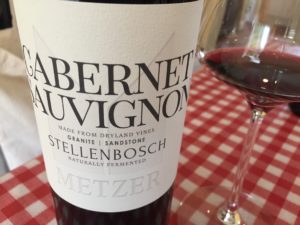
I ended the tasting with a Cabernet Sauvignon, the first release for Metzer. This was another high scoring wine with an elegant and inviting nose. The red cherry, black plum, cassis and eucalyptus aromas were complex and intense, aided by added 10% Shiraz and 5% Cinsault. Green tobacco leafiness emerged on the palate that showed a good structure from tight but not astringent tannins (14 months in 30% new French oak). The Cabernet Sauvignon was approachable and already very drinkable but will age well for another 10 years.
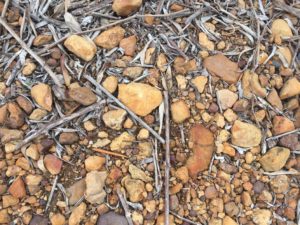

Metzer was the very essence of a boutique estate. The wines were superb with elegant, simple stylish labels (there is also excellent detailed information on the website). I rated the wines highly and the effort to find the winery was well worth it. I liked the cultivar and terroir specificity that came from the carefully selected vineyards in small parcels from the immediate area. Whilst the Stellenbosch or Helderberg location conundrum confused at first, there was nothing contradictory about the wines. Each one was precise, authentic and made with minimum intervention to allow the soils and varietal character to shine best. The wines were pricey (R250 to R300) but this is understandable for a boutique winery producing only 4,500 cases annually. Their quality is without question and so worth the money. The ‘Montane’ Chenin Blanc, for example, gained 5 Platter stars in a very competitive category in 2020. I could very easily have bought every wine had my pockets been deep enough. I would also buy any Metzer wine without prior tasting. That combination is a rare treat for me indeed.
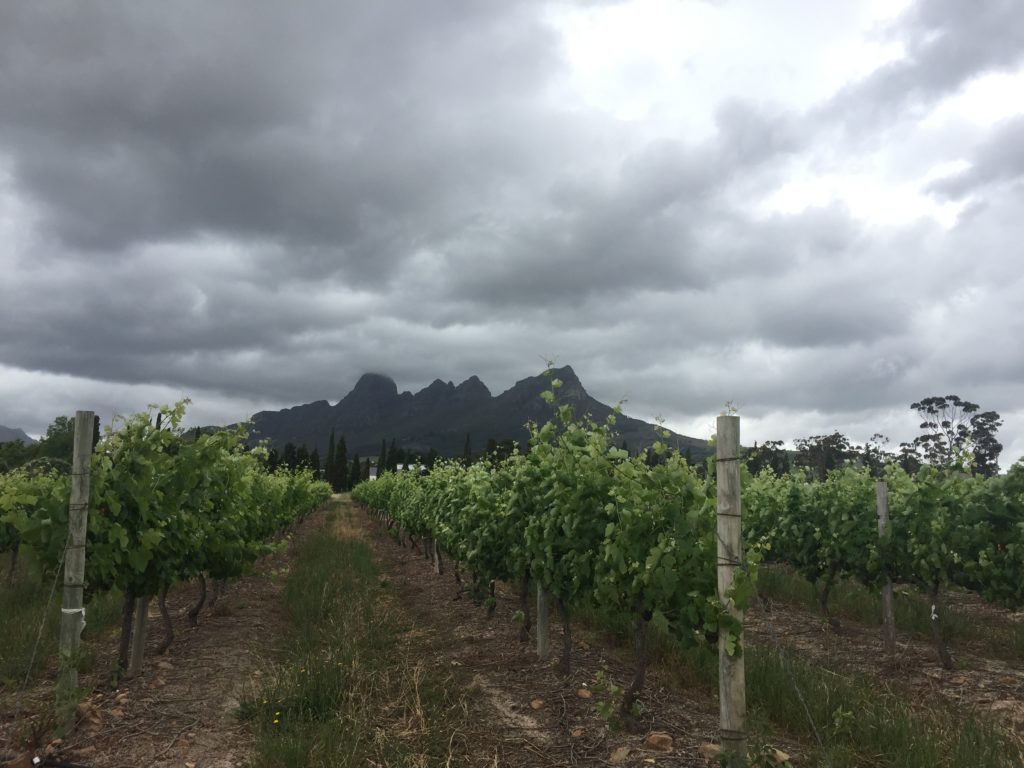
#capewinelover #DrPeter
Wines tasted (bought *):
Sparkling:
2018 Metzer PétNat (100% Chenin Blanc) – R250*
White:
2017 Metzer Family Maritime Chenin Blanc – R250
2017 Metzer Family Montane Chenin Blanc – R300 FAVOURITE WINE
Red:
2018 Metzer Family Cinsault – R300
2017 Metzer Family Shiraz – R240
2017 Metzer Family Cabernet Sauvignon – R240
Book Launch and Review – Platter’s 40th Vintage is Aged to Perfection
Platter’s by Diners Club International 2020 South African Wine Guide – John Platter SA Wine Guide (Pty) Ltd, 2020 – R295
https://www.wineonaplatter.com/
Dr Peter Rating – Experience: 4.5/5
Dr Peter Rating – Book: 5/5
I use Platter’s – or, in full, the Platter’s by Diners Club International 2020 South African Wine Guide – a great deal. Almost every day. I use it to plan where to go for my wine tasting visits. I use it to contact the vineyards. I use it when writing my reviews. I use every section of the book: information on the award winners; the individual winery entries, their summary information, wines and ratings; the summary year’s ratings; the industry details of South Africa’s wine regions, districts and wards; the cultivar summaries; the accommodation listings (less so); and the maps at the back. It is my wine bible.

It was with much excitement that I ventured to the Table View Hotel in the V&A Waterfront, Cape Town, to the launch of the 40th Anniversary Edition. The invite was 6.00pm for 6.30pm and I was there in good time. The dress code was ‘Smart/Casual’ which, among winemakers, left much open to interpretation. Friendships re-acquainted, business completed, some excellent networking opportunities, and tasty canapés consumed with a glass of MCC, it was not until 6.45pm that the Ballroom doors opened. Casual was the order of the day. I should have known it was ‘Africa time’. The room was full and full of expectation. The launch of any Platter’s Guide is rightly secret, from who the major award winners are, to the 5* wines, and even to the cover colour.

Publisher Jean-Pierre ‘JP’ Roussow took to the stage to welcome all, including Esh Naidoo, the Managing Director of Diners Club South Africa. The anticipation was tangible as JP thanked the many Guide contributors before saying a few words about the Guide and its history. The wine landscape was for a very different South Africa 40 years ago when the first Platter’s Guide was launched. The Guide was aimed at the “average, aspiring, enthusiast and the confused” drinker. It cost a mere R6.95 and listed some 1,250 wines that included only 1 Chardonnay. John Platter proclaimed that the “reds lagged only marginally behind the world’s best” and that “the average wines were the highest quality in the world and at the lowest average prices”. I wondered how true that statement remains today. Value for money is certainly a hallmark of South African wine.

Ten years later, in 1990, the number of wines rated in the Guide had swelled to 4,000 – with 40 entries for Chardonnay – with Sauvignon Blanc overshadowing Chardonnay. By 2000, the Guide was bigger still with the commentary that there was a lack of iconic wines being made in volume, at least to reach around the world in sufficient quantity to make Top 10 or Top 20 listings. Four thousand wines became 6,000 wines in 2010. There were 40 5* wines and Sadie Family Wines was the Winery of the Year. Only the numbers have changed since then perhaps. JP later commented on the current lack of volume of iconic wines. He mentioned too that the 125 x 5* wines for 2020 were testament to the improving quality and understanding of what happens in the vineyard by the viticulturalists and a more outward approach by the travelling winemakers.
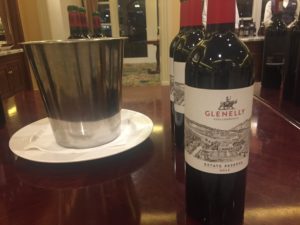
The first closely guarded secret was revealed as JP proudly showed the new Guide to the room, describing the new colour as ‘Karoo Night Sky’. The silver lettering shimmered on the cover beneath the ballroom chandeliers. It looked weighty and classy as befits middle age and, in my opinion, a much better colour than the rather insipid salmon pink of the 2019 Edition. It was time then for JP to handover to Editor Philip van Zyl to announce the 125 5* wines. He explained the 2-step rating method for the 9,000 wines: first, ‘label-sighted’ for the context of site, climate and style (Platter’s is a wine guide and not a competition) and then ‘blind’ for all wines scoring 93/100 and above. The handing out of the certificates – from AA Badenhorst to Warwick – with obligatory winemaker photographs – was done with efficiency and due magnitude. I felt a growing mutual pride and celebration in the room. The Wines of the Year awards followed in some 26 cultivar/blend/style categories that included sparkling, dessert and fortified wines with the top award shared in many tasting categories. The awards included only the second one for a Viognier in 40 years. Many winners of course returned to the stage multiple times.

All that remained before tasting all the 5* winners were the ‘Big 3’ awards. The first, for Newcomer Winery of the Year 2020, was awarded to Peter Ferreira Cap Classique. Like Platter’s itself, I sensed a reassuring stability since Peter Ferreira is no newcomer. He is South Africa’s ‘bubbly king’ as Cellar Master at Graham Beck and renowned for his generosity for sharing knowledge. The award is for his new business venture with wife Ann. The 2012 long-matured Blanc de Blancs MCC was not only the MCC of the Year but also gained the highest score ever awarded by the Guide for a sparkling wine. The Editor’s Award of the Year 2020 was won by Franschhoek winery Boekenhoutskloof. It recognises, as JP and Philip alluded to earlier, the making of iconic wines in large volume and wines made at several price and quality levels. Over 100,000 cases of the high scoring Chocolate Block, for example, are produced to give worldwide reach.

The prestigious and most anticipated award for Top Performing Winery of the Year 2020 was tightly contested. I did wonder who the eventual winner might be as a small number of estates picked up multiple awards during the evening. The margin was extremely close with Mullineux (joint venture Leeu Passant included) just pipping Sadie Family Wines, another multiple winner of the top prize, by virtue of generally slightly higher scores. It was another celebration for the Swartland as well as for Mullineux who not only are the award holders from last year but also won in 2014 and 2016. It was only a week ago that I tasted their wines at the Swartland Producers Street Party in Riebeek Kasteel and watched the Springboks win the World Cup with Andrea and Chris Mullineux (and a few hundred other wine loving supporters). The formalities over it was time to taste many of the top wines.

As for the Guide, it is never easy to keep going for 40 years. Markets and customers change over the years, nay decades, and it is a challenge to keep the connection. Change too fast and wine readers will want more of the old. Stand still and risk that the competition will overtake you. Platter’s has well navigated that middle vine row path. The traditional and reassuringly familiar 0-5 Star rating remains but does so alongside the ‘Parker System’ 100-point metric that is the global standard. Overall, the Guide covers nearly 9,000 wines from 900 producers in just shy of 700 pages. This, intriguingly, is a few pages shorter than the 2019 Edition though I cannot yet see where. Platter’s can be pre-ordered now via their website. The R295 price remains reassuringly stable too and outstanding value for money – given the incredibly detailed information and obvious mammoth judging and editorial effort – and only a modest increase from 2019 (R270). This compares favourably with 2 issues of Decanter Magazine and a cup of Seattle coffee at Exclusive Books. Digital subscription via the Platter’s App – another example where the Guide had moved with the times – is an option (R175) for those who prefer not to carry the weighty tome around with them while wine tasting or shopping. The two can be bought together as the ‘Platter’s Bundle’ for R395, a 20% saving.
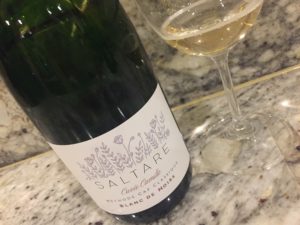
I always enjoy reading the opening 2 sections: Trends in South African Wine and the Editor’s Note. This is where the Guide brings extra value. The topics obviously change each year. I recently read a US report by Beverage Dynamics that predicted alcoholic trends to watch for in 2019-2020. These included inter alia: cans; whiskey sales booming; continuing expansion of rosé (they can make it in 3 weeks!); the slowdown of craft beer; premiumisation; tequila on the rise; explosion in ready-to-drink (mostly cocktail) sales; private label production; single barrel picks (mostly spirits); and low/’healthy’ alcohol beverages. The comparison is interesting with parallels as well as differences. Platter trends in common for 2020 include the move from bulk to premium winemaking as several vineyards have withdrawn from bulk-production to make more profitable wines. Packaging gets a mention too, with a watching stance on wine-in-a-can as well as bottle closure methods. I mentioned above the impact of improved vineyard expertise and more attention in the cellar on wine quality. These 2 trends are covered in the well titled paragraphs of ‘Maximalist work in the vineyards’ and ‘Minimalist work in the cellar’. I won’t expand on more as the Guide far better explains. The last trend poses a question about the developing secondary market. Having been to a few fine wine auctions, many of which had several unsold lots, I share the scepticism but agree the cautious optimism. The modern South African wine industry and its quality improvements remains young. Moreover, there is a culture in drinking young wines – enabled by cash flow conscious wineries – rather than laying wines down to keep. Try asking for a 2017 or even 2004 Sauvignon Blanc or Chardonnay! Climatic conditions too, unlike in much of the Old World, are not conducive to long-term storage whilst temperature and humidity-controlled cellaring is prohibitively expensive to all but the very few. Private label production is a trend here that could easily have also been listed as I see an increasing number of winemakers making their own wines while still tied to the extant wineries. Turning to the Editor’s Note, Philip van Zyl outlines many of the editorial changes and continuations – icon and cellar icons, for instance – from previous editions.

The bulk – or perhaps, the body – of the Platter’s Guide of course remains structurally the same. This is not to devalue the substantial work undertaken to compile the information. This is against a tight annual publication deadline that does not change as the number of wines ever increases. Each vineyard entry gives a brief producer introduction at the top together with a host of detail for winery location and whereabouts, tasting opening times and facilities, contact information, owner/viticulturalist/winemaker names, vineyard area and main cultivars planted, production quantity and the balance between red, rosé, white wines, and much more besides. In between, the wines are listed according to their name, vintage, colour and style, together with their rating and mini-tasting description. Wines gaining 4½ stars and 5 stars are highlighted in red text for easy identification. The remaining sections that make up the final 80-90 pages – the finish – are updated from the 2019 Guide.

How to improve? The Platter’s Guide is such a well-established brand – worthy of an Editor’s Award for its iconic status itself – that it is difficult to know. It is one of the few wine guides in the world that aims to taste and rate every wine from every vintage. The detailed content for each winery and its wines is as self-defining as it is essential and so I cannot see any opportunity there. I don’t personally use the Touring Wine Country section that covers Wine Routes, Wineland Tourism Offices, Specialist Wine Tours, Restaurants and Accommodation a great deal but then I live in Cape Town and so have less need, preferring to search using the internet for restaurant menus or accommodation rather than the Guide. This leaves format and layout. The A5 format is a trusted one for any travel or like guide and, whilst bulky at 700 pages, does not really lend itself to a different size or shape. I have suggested before that a ribbon and/or bookmark – as included in many previous editions – would aid page-keeping for a book of such thickness and number of pages. It is something I have discussed with the publisher and accept the reality that manual attachment would adversely impact on price and printing deadlines.

More radical would be to change scope of the Guide and its awards. Sustainability is not only vital for the future of our planet, but it can make good business sense too. A new award for, say, Organic Winery of the Year, to include the biodynamic producers, would give a useful stimulus to the style and sector. Mindful of the Wine and Spirits Education Trust decision last year to separate wine from spirits learning, there must be a business opportunity for a Platter’s South African Spirits Guide. This could include the gin, rum, brandy, grappa and other distilled beverages that are being made for an increasing number of brands, many produced by South African wineries. There is in my mind a need for such a guide and Platter’s has the editorial and operational experience to deliver as well as the brand trust and recognition to make a success of such a new initiative.

In sum, the 2020 Platter’s Guide is as excellent as ever. The quality in both content and production remains. There is no other wine guide to match it for the comprehensive and trusted content – as reliable as Mullineux winning the Top Performing Winery Award. The Guide remains excellent value for money and is indispensable for any wine lover whether, in the words of the very first Edition 40 years ago, you are an “average, aspiring, enthusiast or confused” drinker. Buy it now to get the most use from it. The new Guide, with its sublime Karoo night sky colour, will certainly give me 2020 vision for the wine year ahead.




